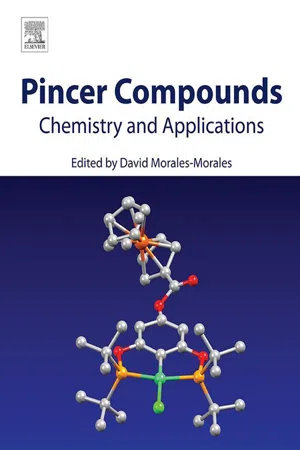
- 754 pages
- English
- ePUB (mobile friendly)
- Available on iOS & Android
About This Book
Pincer Compounds: Chemistry and Applications offers valuable state-of-the-art coverage highlighting highly active areas of research—from mechanistic work to synthesis and characterization. The book focuses on small molecule activation chemistry (particularly H2 and hydrogenation), earth abundant metals (such as Fe), actinides, carbene-pincers, chiral catalysis, and alternative solvent usage. The book covers the current state of the field, featuring chapters from renowned contributors, covering four continents and ranging from still-active pioneers to new names emerging as creative strong contributors to this fascinating and promising area.
Over a decade since the publication of Morales-Morales and Jensen's The Chemistry of Pincer Compounds (Elsevier 2007), research in this unique area has flourished, finding a plethora of applications in almost every single branch of chemistry—from their traditional application as very robust and active catalysts all the way to potential biological and pharmaceutical applications.
- Describes the chemistry and applications of this important class of organometallic and coordination compounds
- Includes contributions from global leaders in the field, featuring pioneers in the area as well as emerging experts conducting exciting research on pincer complexes
- Highlights areas of promising and active research, including small molecule activation, earth abundant metals, and actinide chemistry
Frequently asked questions
Information
Chiral Pincer Complexes for Asymmetric Reactions
Abstract


Keywords
1.1 Introduction

1.2 Reduction Reactions


Table of contents
- Cover image
- Title page
- Table of Contents
- Copyright
- Dedication
- List of Contributors
- Preface
- Chapter 1. Chiral Pincer Complexes for Asymmetric Reactions
- Chapter 2. Well-defined Iron and Manganese Pincer Catalysts
- Chapter 3. The Pincer Complexes of Group 13–15 Elements: Recent Developments
- Chapter 4. Reduction of CO2 Mediated or Catalyzed by Pincer Complexes
- Chapter 5. Mechanistic Insights and Computational Prediction of Base Metal Pincer Complexes for Catalytic Hydrogenation and Dehydrogenation Reactions
- Chapter 6. Hydrogenation and Dehydrogenation Reactions Catalyzed by Iron Pincer Compounds
- Chapter 7. Actinide Pincer Chemistry: A New Frontier
- Chapter 8. Complexes of NHC-Based CEC Pincer Ligands: Structural Diversity and Applications
- Chapter 9. Transition Metal Pincer Complexes With Chiral Imidazoline Donor(s): Synthesis and Asymmetric Catalysis
- Chapter 10. Chiral NCN Pincer-Type Catalysts Having Bis(imidazoline)s
- Chapter 11. Transition Metal Pincer Complexes with a Central sp3-Hybridized Carbon Atom
- Chapter 12. CCC-NHC Pincer Complexes: Synthesis, Applications, and Catalysis
- Chapter 13. Metal Pincer Catalysts in Aqueous Media: Approaches With Water as Solvent, Reagent, and Molecular Hydrogen Storage
- Chapter 14. Pincers Based on Dicarboxamide and Dithiocarboxamide Functional Groups
- Chapter 15. Pincer Complexes of Iron and Their Application in Catalysis
- Chapter 16. Osmium Complexes With POP Pincer Ligands
- Chapter 17. Pincer Carbenoid Complexes With Late Transition Metals: Synthesis, Electronic Structure, and Reactivity
- Chapter 18. Pincer Iridium and Ruthenium Complexes for Alkane Dehydrogenation
- Chapter 19. Silicon-Based Pincers: Trans Influence and Functionality
- Chapter 20. Transition Metal Complexes With Anionic Sulfur-Based Pincer Ligands
- Chapter 21. Metalation and Transmetalation Chemistry of Pyridine- and Aryl-Linked Bis-NHC Pincer Ligands
- Chapter 22. Unsymmetrical Pincer Palladacycles Synthesis and Reactivity
- Chapter 23. Benzene-Derived Organometallic Pincer Compounds Bearing Six-Membered Metallacycles and Up
- Chapter 24. Chemistry of Mn and Co Pincer Compounds
- Chapter 25. Selective Deuteration of Organic Compounds Catalyzed by Ruthenium Pincer Complexes
- Chapter 26. σ-Organometallic Chemistry With 2,6-Bis(imino)pyridine Ligands: New Pathways to Innovative Pincer Architectures
- Chapter 27. Use of Pincer Compounds as Metal-Based Receptors for Chemosensing of Relevant Analytes
- Chapter 28. Advances in the Design and Application of Redox-Active and Reactive Pincer Ligands for Substrate Activation and Homogeneous Catalysis
- Chapter 29. The Chemistry of Bisphosphomide and 1,2-Phenylenediamine Based PBP Pincer Transition Metal Complexes and Catalytic Applications
- Chapter 30. Ligand-Introduction Synthesis of NCN-Pincer Complexes and their Chemical Properties
- Chapter 31. Pincer Complexes of Gold: An Overview of Synthesis, Reactivity, Photoluminescence, and Biological Applications
- Chapter 32. Semirigid Pincer-Like SiPSi Ligands: Classical Versus Nonclassical Coordination Modes at Ru, Rh, Ir, and Pt
- Chapter 33. Conclusions and Personal Comment
- Index